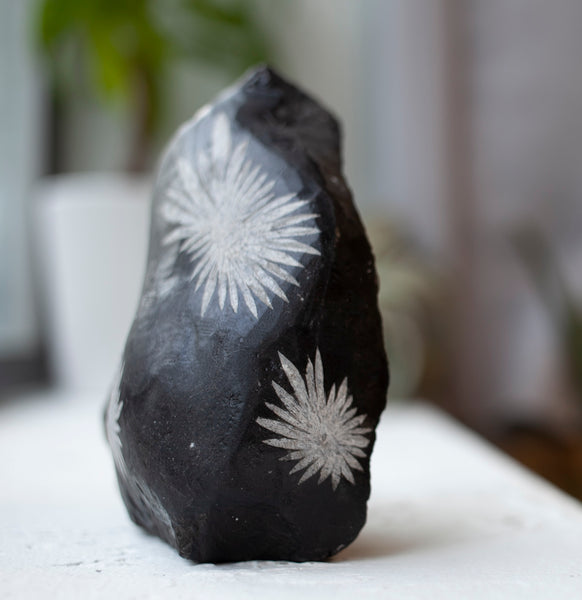Chrysanthemum stones might look painted or like fossils but they are actually natural crystals that formed during the Permian age, or 248 to 290 million years ago. Chrysanthemum stones formed at the bottom of ancient oceans, where the pressure is immense. This caused the Celestite crystals to grow outward, pressed within the carbon-rich seabed.
What is a Chrysanthemum stone?
Chrysanthemum stones are black stones with what appears to be a white flower blooming on its surface. These wonders occur naturally thanks to Celestite crystals. Celestite forms crystals in a star-like pattern.
"The white pattern on the rock is formed of crystals of celestine (or celestite), a strontium-sulfate mineral. Celestine commonly forms elongate crystals of the form seen here, although these are fairly rare in that they’re so thin and on the surface of another rock. Strontium is often concentrated in carbonate rocks and probably grew on these larger limestone surfaces as a consequence of flowing water after the rocks were deposited; a small crystal could nucleate at the center of the flower and crystals would then grow outwards from that center point." geologyin
Along with Celestite, Chrysanthemum stones contain many trace elements including gold, silver, bismuth, selenium, and strontium. But the natural crystal habit of Celestite is why it appears as if a flower has grown on a stone. This isn't the first time we've seen Celestite make star shapes in ancient history. On our Celestite meaning page, we describe the Acantharea, which an ancient life form that actually made its skeleton from Celestite! It is the only creature known to do so - check it out here.
Because of their rarity and unusual beauty, Chrysanthemum stones are popular among collectors. They also have a beautiful meaning, making them highly sought pieces for spiritual growth and emotional healing.

Learn More about Celestite Here
See all available Chrysanthemum Stones here
By Cape Cod Crystals
Citations
http://www.geologyin.com/2018/10/chrysanthemum-stone-natural-flower-stone.html#yd0Wp8s9BCTzlYC3.99



2 comments
@Victoria Firewind Hi Victoria, It is correct that Celetite is Strontium but Chrysanthemum stones also contain Strontium Sulphate. Before Calcium Carbonate pseudomorphs, it is actually predominately Celetite and Celetite is what creates the flower shape. Unfortunately, you won’t find this information on Wikipedia, but there are several articles that describe their growth and composition such as the one I linked in the article or these:
Yesen Fang, Jinman Fang and Xuying Yuan (1988): Celestites in carbonate in Yonghe, Liuyang County, Hunan Province. Acta Sedimentologica Sinica 6
Guangsheng Zhang and Jiazhen Li (1999): Elementary study on chrysanthemum stone from Permian rocks in Laibin of Guangxi. Guangxi Geology 16
Jiaxin Yan, Chunhua Shi, Junhong Li, and Carlson, E.H. (2001): Replacement of Chrysanthemum-Shaped Celestite in the Chihsia [Qixia] Formation of South China and its Geological Implications. Acta Petrologica et Mineralogica 20(1), 75-83.
This is not factual. Celestine contains Strontium. Chrysanthemum stones are andalusite, meaning Aluminum Silicate. Please correct this misinformation. Thanks.